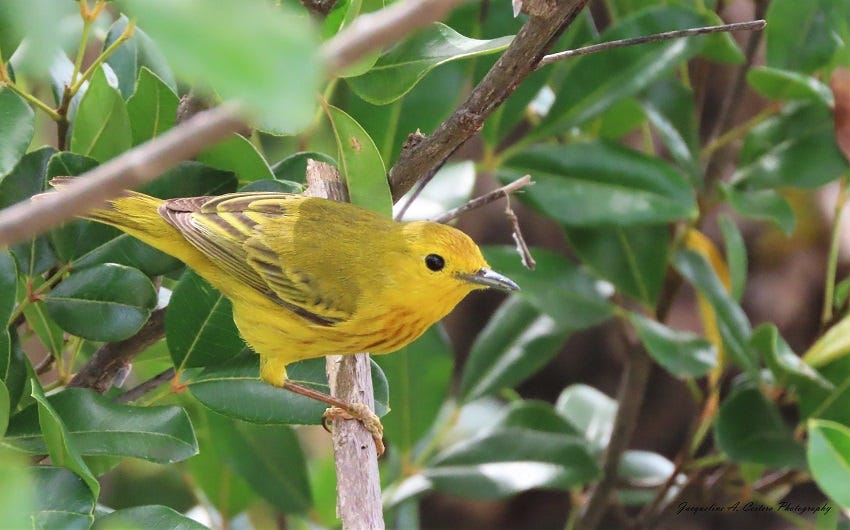Spring is in the air meaning birds are on the move. After spending the winter in the south, they are heading back to their breeding grounds in the north. This is true for most species of warblers.
For Anguilla’s resident Yellow Warblers, it means it’s time to find a mate. They get to skip the tedious travel piece and focus on singing!
Birds of the World describes their song as follows:
“Song. Songs delivered primarily by males; female song recorded rarely (Hobson and Sealy 1990). Discussion here refers to male song. Songs consist of 2–5 clusters (“phrases”) of usually repeated short units (“syllables”; see illustration in Spector 1991) for a total of about 6–10 syllables/song. Song about 1 s in length, highly variable in details. For males with >1,000 recorded songs, 10–17 song types identified (n = 8); song types as rare as 1 of 5,628 recorded songs (Spector 1992). Frequency range typically from 3–8 kHz with greatest concentra-tion of power in range 4.5–5.5 kHz (DAS). Some songs fit the mnemonic “sweet sweet sweet I'm so sweet” or “sweet sweet sweet sweeter than sweet,” but songs can be quite variable within and between populations.“
Further:
“The Yellow Warbler is the most strikingly yellow of New World warblers. Yellow Warblers also have variable amounts of chestnut streaking on the breast, and southern forms have variable amounts of chestnut on the head. The streaking is usually more prominent in adult males and less so in females and immatures.”
The breast streak is readily apparent in the top photo.
There are also three main groups of the Yellow Warbler. The most common one occurs in North America and tends to migrate. The southern male birds have varying amounts of chestnut on their heads. The Mangrove Warbler has a chestnut hood and occurs in South America.
In the West Indies, the male has a chestnut cap and is known as a Golden Warbler. The chestnut cap is nicely displayed in the photograph below. That cap and the breast streaks intensify with the onset of the breeding season. I often hear the bird rather than see it, but we get a few migrants each season.
Breeding season ramps up in late March and early April, and the song becomes more frequent. The song is often prefaced with a chipping sound as they feed in the bushes.
The nest is built in the fork of a tree approximately 3 to 5 feet off the ground. On Anguilla, White Cedar or Buttonwoods are the most likely trees used.
The female builds the nest over four days. It is a deep cup comprised of plant fibers and bark. Nests are not reused, but materials may be.
Four or five grayish-white eggs are laid in the nest. The female alone incubates the eggs for 10 to 13 days. Chicks emerge with a light gray down and are dependent on the parents. Only the female has a brood patch and takes full responsibility for brooding.
Both parents feed the chicks over 8 to 10 days, but the female does most of the work. Chicks may remain with the parents up to three weeks after the fledge.
In my experience, the nests are well hidden, but I often see newly fledged chicks with their parents.
Golden Warblers are most active in the morning during the Spring, so listen carefully for their beautiful song.


Beginning in March, keep your eyes open for other species of Warblers as they journey northward. Lucky birders might pick up Prothonotary, Black and White, Prairie, Northern Parula, Yellow-rumped, and Blackpoll Warblers as they head off to their breeding grounds in North America.







Loving your birds and content, Jackie❣️
So cute!!!